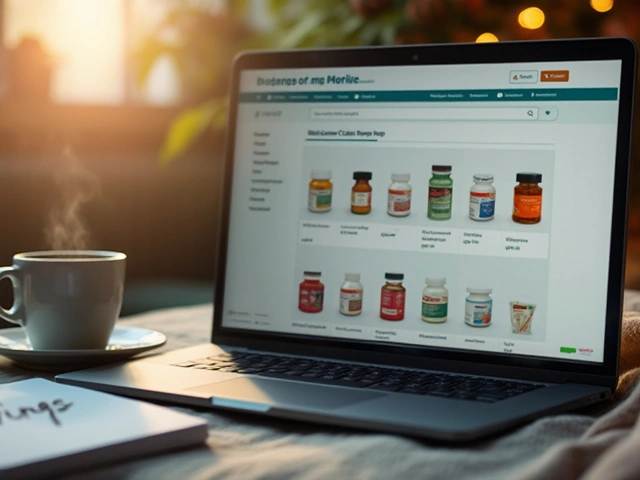Intermittent Claudication is a painful cramping in the calf or thigh muscles that appears during walking and eases with rest, usually caused by narrowed leg arteries. It signals the presence of Peripheral Artery Disease (PAD) and affects roughly 12% of adults over 60 in the UK.
TL;DR - Quick Action Points
- Start a supervised walking program - 10‑15min, 3‑5 times a week.
- Quit smoking; nicotine cuts blood flow by up to 30%.
- Take a statin and, if advised, an antiplatelet drug to keep arteries clear.
- Track your pain distance with a simple diary.
- Schedule an vascular surgeon review if pain occurs sooner than 100m or worsens.
What Is Intermittent Claudication?
When the arteries supplying the lower limbs become narrowed by atherosclerotic plaque, blood can’t meet the oxygen demand of working muscles. The resulting ischemia triggers a burning or aching sensation, most often in the calves. The pain disappears after a few minutes of rest because the oxygen demand drops. This pattern differentiates claudication from joint pain, which usually persists regardless of activity.
Key stats from the British Society of Vascular Medicine show that 1 in 8 over‑70s report leg discomfort that fits the classic description, yet only 35% receive formal PAD screening.
Risk Factors That Accelerate the Cycle
Understanding the contributors helps you target the right interventions. The main culprits are:
- Smoking - nicotine causes vasoconstriction and promotes plaque buildup.
- Diabetes - high glucose damages the inner lining of arteries.
- Hypertension - chronic pressure speeds plaque formation.
- Hyperlipidaemia - elevated LDL cholesterol directly feeds atherosclerosis.
- Age and male sex - prevalence climbs sharply after 60.
Addressing any one of these can slow disease progression, but the biggest payoff comes from quitting smoking and controlling cholesterol.
How Doctors Measure Severity
Clinicians rely on the Ankle‑Brachial Index (ABI), a simple bedside test that compares blood pressure at the ankle with that in the arm. An ABI of 0.90‑1.30 is normal; values below 0.90 indicate PAD, and the lower the number, the more severe the flow restriction.
For example, an ABI of 0.65 typically correlates with walking pain after 100m, whereas 0.45 often means pain after just 30m. Knowing your ABI helps tailor the intensity of exercise therapy and decide when revascularisation is needed.

Core Management Strategies
Evidence from the EVAR trial (2022) shows that a combined approach-exercise, medication, and lifestyle change-reduces walking distance limitation by about 45% within six months.
1. Exercise Therapy - The Cornerstone
Supervised walking is the most cost‑effective treatment. The goal is to walk until moderate pain appears, then rest for one minute, and repeat. Over weeks, the pain‑free distance expands because collateral vessels develop.
Typical prescription:
- Warm‑up for 3minutes (slow stroll).
- Walk at a brisk pace until you feel a dull ache (usually 3‑5minutes).
- Rest 1‑2minutes, then resume.
- Complete 3‑4 cycles per session, 3‑5 times weekly.
If a local NHS physiotherapy clinic isn’t available, a home‑based program using a treadmill or a flat park path works just as well, provided you keep a pain diary.
2. Medications - Keeping the Arteries Clear
Two drug families dominate the regimen:
- Statins (e.g., atorvastatin 20mg daily) lower LDL cholesterol by up to 50%, stabilising plaque.
- Antiplatelet therapy (usually low‑dose aspirin 75mg) reduces clot formation that could abruptly cut off flow.
Guidelines from NICE (2023) recommend both for anyone with PAD, unless contraindicated.
3. Smoking Cessation - The Fastest Fix
Quitting smoking can improve walking distance by 20‑30% in just three months. Options include nicotine‑replacement patches, varenicline, and structured behavioural support from local stop‑smoking services.
4. Nutrition and Weight Management
A Mediterranean‑style diet-rich in oily fish, nuts, olive oil, fruits and veg-has been linked to a 15% slower ABI decline per year. Maintaining a healthy BMI (<25kg/m²) also reduces arterial pressure.
5. Revascularisation - When Conservative Measures Fail
If pain occurs before 100m despite optimal medical therapy, an vascular surgeon may recommend angioplasty or a bypass. These procedures restore flow quickly, but they carry procedural risks and don’t replace the need for lifestyle changes.
| Strategy | Primary Benefit | Typical Duration to See Effect | Key Consideration |
|---|---|---|---|
| Exercise Therapy | Improves collateral circulation | 4‑6 weeks | Requires consistency; pain may initially worsen |
| Statin Medication | Lowers LDL, stabilises plaque | 2‑3 months | Monitor liver enzymes |
| Antiplatelet Therapy | Reduces clot risk | Immediate | Bleeding risk in ulcer patients |
| Smoking Cessation | Restores vasodilation | 1‑3 months | Behavioural support improves success |
| Revascularisation | Rapid symptom relief | Days to weeks | Invasive; requires post‑op rehab |
Practical Tips for Daily Living
Beyond formal treatment, small habit tweaks make a big difference:
- Carry a small notebook to log the distance you walked before pain appears; aim to increase that distance by 10% each week.
- Wear loose, breathable shoes with good arch support; tight footwear can compress vessels further.
- Elevate your legs for a few minutes after long periods of standing to boost venous return.
- Stay hydrated - dehydration thickens blood and worsens ischemia.
- Schedule a short walk break every hour if you have a desk job; even 2‑minute walks keep circulation flowing.
When to Seek Specialist Care
If any of the following occur, book an appointment with a vascular surgeon or a PAD clinic promptly:
- Pain starts before you can walk 100m (about the length of a city block).
- Rest pain that wakes you at night.
- Sudden loss of colour or temperature in the foot (possible acute limb ischaemia).
- Non‑healing foot ulcer despite good wound care.
Early referral improves outcomes; 70% of patients who receive revascularisation within three months avoid amputation.
Related Concepts Worth Exploring
Once you’ve got a handle on claudication, you might want to read up on these adjacent topics:
- Chronic Limb‑Threatening Ischaemia - a severe PAD stage.
- Cardiovascular risk calculators - to gauge heart‑attack risk in PAD patients.
- Home‑based tele‑monitoring of walking distance - using smartphone apps.
- Psychological impact of chronic leg pain - coping strategies.

Frequently Asked Questions
What exactly triggers the pain in intermittent claudication?
The pain is caused by insufficient oxygen (ischemia) reaching the calf muscles during activity. Narrowed arteries restrict blood flow, and when the muscles work harder than the blood can supply, they produce a burning ache that stops when you rest.
How often should I do the walking program?
Aim for 10‑15minutes per session, 3‑5 times a week. Consistency is key - even short bouts add up, and you’ll notice a steady increase in pain‑free distance after about four weeks.
Can medication alone cure claudication?
Medication (statins, antiplatelet agents) slows disease progression and reduces cardiovascular risk, but it rarely eliminates leg pain on its own. Combining drugs with regular exercise gives the best functional improvement.
Is it safe to walk if I have severe heart disease?
Most patients with PAD can exercise safely, but if you have known coronary artery disease, get clearance from your GP or cardiologist first. A graded treadmill test can confirm you’re within a safe heart‑rate zone.
When is surgery the right choice?
If walking pain starts under 100m despite optimal medical therapy, or if you develop rest pain, non‑healing ulcers, or rapid ABI decline, a vascular surgeon will discuss angioplasty or bypass as options.






8 Comments
John Keough
September 21, 2025 AT 21:09 PMA good way to boost walking tolerance is to incorporate interval training after the basic 10‑15‑minute sessions. Start with a brisk walk until moderate discomfort, then pause for a minute, and repeat the cycle two more times. Over a few weeks the pain‑free distance usually expands as collateral vessels develop. Keep a simple diary of distance and pain level to spot gradual improvement. Pair the walks with light resistance work for calves to strengthen the muscles without adding strain.
David Stephen
October 3, 2025 AT 10:56 AMKeep the steps steady and the progress will follow.
Roberta Giaimo
October 15, 2025 AT 00:43 AMYour notation of the ABI thresholds is spot on; it helps set realistic expectations for patients. 😊
Tom Druyts
October 26, 2025 AT 13:29 PMDon't let the early aches discourage you-every short bout builds endurance. Think of each walk as a tiny victory against a stubborn plaque. Celebrate the milestones, even if it's just an extra ten meters.
Julia C
November 7, 2025 AT 03:16 AMWhile statins lower LDL, many studies hide the long‑term metabolic fallout behind glossy press releases. The pharma lobby pushes antiplatelet pills without mentioning subtle bleeding risks that get buried in fine print. It's worth scrutinizing the data before committing to lifelong medication. Stay skeptical and demand transparent trial outcomes.
John Blas
November 18, 2025 AT 17:03 PMOh, the endless parade of generic walking tips-so inspiring, right? If only every brochure promised miracle distances without the brutal reality of pain.
Darin Borisov
November 30, 2025 AT 06:49 AMThe contemporary discourse surrounding peripheral arterial disease management is regrettably bereft of a cogent, evidence‑based framework that integrates both biomechanical and pharmacological paradigms within a unified therapeutic schema. In the United Kingdom, where the NHS paradigm ostensibly prioritizes cost‑effectiveness, the prevailing reliance on rudimentary supervised walking regimens reflects a myopic adherence to antiquated clinical dogma. Such protocols, albeit accessible, fail to capitalize on the nuanced interplay between endothelial shear stress modulation and adaptive angiogenesis, phenomena extensively documented in the annals of vascular physiology. A more sophisticated approach mandates the incorporation of high‑intensity interval ambulation, calibrated to elicit supra‑threshold metabolic demand while preserving musculoskeletal integrity. Concomitantly, the judicious titration of LDL‑lowering agents, encompassing not only statins but also emerging PCSK9 inhibitors, should be predicated upon genotype‑guided pharmacogenomic profiling. Neglecting to stratify patients according to polymorphic variations in CYP3A4 and SLCO1B1 enzymes perpetuates suboptimal therapeutic windows and potentiates adverse event incidence. Moreover, the cavalier dismissal of nutraceutical adjuncts-such as omega‑3 enriched marine oils, polyphenol‑rich extracts, and polyunsaturated fatty acid composites-exemplifies a reductive reductionism antithetical to holistic medicine. When contextualized within a broader sociopolitical canvas, the national health infrastructure must transcend parochial budgetary constraints to foster interdisciplinary collaborations between vascular surgeons, exercise physiologists, and behavioral psychologists. Only through such integrative consortia can we engender a paradigm shift from palliative symptom suppression toward genuine functional restitution. The extant literature, ranging from the EVAR trial to subsequent meta‑analyses, unequivocally substantiates the synergistic benefit of combined modality therapy, yet implementation remains sporadic at best. To redress this lacuna, policy architects should mandate the establishment of accredited vascular rehabilitation centers equipped with telemetry‑enabled gait analysis platforms. These facilities would facilitate real‑time monitoring of ankle‑brachial index dynamics, thereby enabling precise titration of exercise intensity and pharmacologic dosing. In addition, a robust patient education framework, leveraging digital health ecosystems, can democratize access to personalized walking curricula irrespective of geographical locale. It is incumbent upon clinicians to eschew the allure of one‑size‑fits‑all prescriptions and, instead, embrace a patient‑centred algorithmic model that dynamically adjusts to longitudinal outcome metrics. Such a model, synergistically aligned with national health objectives, would not only attenuate the morbidity burden of PAD but also reinforce the United Kingdom's stature as a vanguard of vascular excellence. In summation, the amalgamation of high‑resolution hemodynamic assessment, genotype‑informed pharmacotherapy, and structured interval ambulation constitutes the quintessential blueprint for contemporary intermittent claudication management.
Sean Kemmis
December 11, 2025 AT 20:36 PMSounds like a textbook plan. Too bad most patients ignore it.